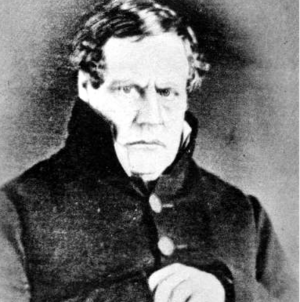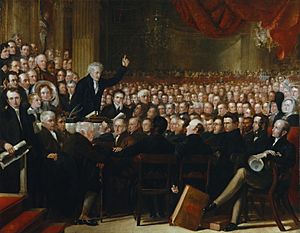Jonathan Miller (abolitionist) facts for kids
Quick facts for kids
Jonathan Peckham Miller
|
|
|---|---|

Miller around 1840
|
|
| Born | February 24, 1797 |
| Died | February 17, 1847 (aged 49) |
| Resting place | Green Mount Cemetery, Montpelier, Vermont |
| Nationality | American |
| Education | University of Vermont |
| Known for | Advocate for abolition of slavery and women's rights |
| Spouse(s) | Sarah Arms Miller |
| Children | Sarah Miller Keith |
Colonel Jonathan Peckham Miller (born February 24, 1797 – died February 17, 1847) was an important American activist from Vermont. He fought for freedom in Greece and later became a politician. He strongly supported ending slavery and giving women equal rights.
Jonathan and his wife, Sarah Arms Miller, used their home to help enslaved people escape. Their house was a secret stop on the Underground Railroad. This was a network of safe houses and routes for people seeking freedom.
Miller represented the town of Berlin in the Vermont Legislature from 1831 to 1833. In his last year, he suggested a rule to end slavery in the District of Columbia. People called him "The American Dare Devil" because of his brave actions for freedom.
Contents
Early Life and Adventures
Jonathan Miller was born in Randolph, Vermont, in 1797. He started military training during the War of 1812. In 1817, he joined the U.S. Army for two years.
Later, he went to college. He enrolled at Dartmouth College in 1821. After a few weeks, he moved to the University of Vermont. He studied there until 1824.
Helping Greece Gain Freedom
The Greek War of Independence started in 1821. This was a fight for Greece to become free from the Ottoman Empire. Miller heard their call for help. He traveled to Greece in 1824 to join the fight.
He showed great bravery in the fighting units. Because of his courage, he earned the rank of Colonel. After returning to America, he still cared deeply about the Greek cause. He raised thousands of dollars and collected supplies to help. Miller made sure these supplies reached the people in Greece. They were shared among those affected by the war.
Miller came back to Vermont in 1827. He brought with him a four-year-old Greek refugee named Lucius Miltiades. Miller adopted Lucius and raised him as his own son.
Marriage and the Underground Railroad
Jonathan Miller married Sarah Arms on June 26, 1828. It was Sarah who first became involved in helping enslaved people escape. Jonathan soon joined her.
The Millers used their home to shelter people escaping slavery. They also helped the Underground Railroad financially. They even used stagecoaches to secretly move people seeking freedom.
Fighting for Rights
Miller's interest in human rights led him to become a lawyer in 1831. That same year, he also ran for the Vermont legislature. He organized and gave speeches to support the abolitionist cause. Abolitionists were people who wanted to end slavery.
In 1833, he proposed a rule in the legislature. It asked senators to support anti-slavery efforts. In 1835, a famous reformer named Samuel Joseph May came to speak in Montpelier. Miller stepped in to protect May from a hostile crowd.
Vermont was a very strong anti-slavery state. In 1840, the legislature said that enslaved people who escaped had a right to a trial. Even though the Supreme Court later overturned this, Vermont found other ways to fight slavery.
Advocating for Women's Rights
In 1840, Miller was chosen to go to the World Anti-Slavery Convention in London, England. Before this convention, there was a big discussion in America. Leaders like Wendell Phillips and William Lloyd Garrison wanted women to be full members of anti-slavery groups. They also wanted women to have leadership roles. Miller actively supported this idea.
So, some women delegates traveled to the London convention. However, the convention leaders decided to exclude women. This meant women were not allowed to be full participants. A last-minute debate happened to try and change this.
Miller spoke out boldly. Even though Vermont had only sent male delegates, he argued for women's inclusion. He said that if all their female friends were there, the hall would not be big enough. He reminded everyone that women were among the first abolitionists. He said they had "established a standard of liberty" that their husbands then followed.
Despite Miller's strong words, the convention leaders were not convinced. Women were allowed to attend, but they had to sit separately. They were also not allowed to speak. Miller took his assigned seat. Another American delegate, William Adam, chose to sit with the women in protest.
Miller was later included in a famous painting of the convention. This painting is now in the National Portrait Gallery in London. The next year, Miller spoke at another Anti-Slavery Convention in New Hampshire. He spoke alongside William Lloyd Garrison and Nathaniel Peabody Rogers.
Later Life and Legacy
Jonathan Miller continued to work for the end of slavery. He died in Montpelier, Vermont, on February 17, 1847. He is buried at Green Mount Cemetery in Montpelier. His life showed a strong commitment to freedom and equality for all people.
See also
- Samuel Gridley Howe
- John Dennison Russ
- James Jakob Williams


